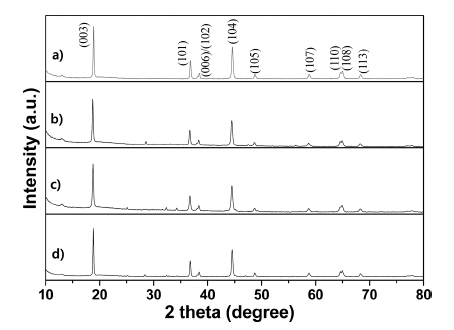Search
- Page Path
- HOME > Search
- [Korean]
- Effect of Single and Dual Doping of Rare Earth Metal Ce and Nd Elements on Electrochemical Properties of LiNi0.83 Co0.11Mn0.06O2 Cathode Lithium-ion Battery Material
- Yoo-Young Kim, Jong-Keun Ha, Kwon-Koo Cho
- J Korean Powder Metall Inst. 2019;26(1):49-57. Published online February 1, 2019
- DOI: https://doi.org/10.4150/KPMI.2019.26.1.49

- 1,628 View
- 16 Download
- 2 Citations
-
 Abstract
Abstract
 PDF
PDF Layered LiNi0.83Co0.11Mn0.06O2 cathode materials single- and dual-doped by the rare-earth elements Ce and Nd are successfully fabricated by using a coprecipitation-assisted solid-phase method. For comparison purposes, nondoping pristine LiNi0.83Co0.11Mn0.06O2 cathode material is also prepared using the same method. The crystal structure, morphology, and electrochemical performances are characterized using X-ray diffraction (XRD), scanning electron microscopy (SEM), energy dispersive spectrometer (EDS) mapping, and electrochemical techniques. The XRD data demonstrates that all prepared samples maintain a typical α-NaFeO2-layered structure with the
R-3m -
Citations
Citations to this article as recorded by- Numerical approach for lithium-ion battery performance considering various cathode active material composition for electric vehicles using 1D simulation
Heewon Choi, Nam-gyu Lim, Seong Jun Lee, Jungsoo Park
Journal of Mechanical Science and Technology.2021; 35(6): 2697. CrossRef - Synthesis of CeVO4-V2O5 nanowires by cation-exchange method for high-performance lithium-ion battery electrode
Xueliu Xu, Shiying Chang, Taofang Zeng, Yidan Luo, Dong Fang, Ming Xie, Jianhong Yi
Journal of Alloys and Compounds.2021; 887: 161237. CrossRef
- Numerical approach for lithium-ion battery performance considering various cathode active material composition for electric vehicles using 1D simulation
- [Korean]
- Shape Control of Anodic Aluminum Oxide and Effect as Support of Silicon Powder Electrode
- Ju-Seok Song, Jong-Keun Ha, Yoo-Young Kim, Dong-Kyu Park, In-Shup Ahn, Jou-Hyeon Ahn, Kwon-Koo Cho
- J Korean Powder Metall Inst. 2015;22(4):240-246. Published online August 1, 2015
- DOI: https://doi.org/10.4150/KPMI.2015.22.4.240

- 553 View
- 1 Download
- 1 Citations
-
 Abstract
Abstract
 PDF
PDF Anodic aluminum oxide (AAO) has been widely used for the development and fabrication of nano-powder with various morphologies such as particle, wire, rod, and tube. So far, many researchers have reported about shape control and fabrication of AAO films. However, they have reported on the shape control with different diameter and length of anodic aluminum oxide mainly. We present a combined mild-hard (or hard-mild) anodization to prepare shape-controlled AAO films. Two main parameters which are combination mild-hard (or hard-mild) anodization and run-time of voltage control are applied in this work. The voltages of mild and hard anodization are respectively 40 and 80 V. Anodization was conducted on the aluminum sheet in 0.3 mole oxalic acid at 4°C. AAO films with morphologies of varying interpore distance, branch-shaped pore, diameter-modulated pore and long funnel-shaped pore were fabricated. Those shapes will be able to apply to fabricate novel nano-materials with potential application which is especially a support to prevent volume expansion of inserted active materials, such as metal silicon or tin powder, in lithium ion battery. The silicon powder electrode using an AAO as a support shows outstanding cycle performance as 1003 mAh/g up to 200 cycles.
-
Citations
Citations to this article as recorded by- Nano silicon encapsulated in modified copper as an anode for high performance lithium ion battery
Jong-Keun Ha, Anupriya K. Haridas, Gyu-Bong Cho, Hyo-Jun Ahn, Jou-Hyeon Ahn, Kwon-Koo Cho
Applied Surface Science.2019; 481: 307. CrossRef
- Nano silicon encapsulated in modified copper as an anode for high performance lithium ion battery
- [Korean]
- Fabrication of Iron-Molybdenum Alloyed Nanoparticle and Nanowire using Chemical Vapor Condensation(CVC)
- Jong-Keun Ha, Kwon-Koo Cho, Ki-Won Kim, Kwang-Sun Ryu
- J Korean Powder Metall Inst. 2010;17(3):223-229.
- DOI: https://doi.org/10.4150/KPMI.2010.17.3.223

- 320 View
- 1 Download
-
 Abstract
Abstract
 PDF
PDF - Iron(Fe)-Molybdenum(Mo) alloyed nanoparticles and nanowires were produced by the chemical vapor condensation(CVC) process using the pyrolysis of iron pentacarbonyl(Fe(CO)_5) and Molybdenum hexacarbonyl(Mo(CO)_6). The influence of CVC parameter on the formation of nanoparticle, nanowire and size control was studied. The size of Fe-Mo alloyed nanoparticles can be controlled by quantity of gas flow. Also, Fe-Mo alloyed nanowires were produced by control of the work chamber pressure. Moreover, we investigated close correlation of size and morphology of Fe-Mo nanoparticles and nanowires with atomic quantity of inflow precursor into the electric furnace as the quantitative analysis. Obtained nanoparticles and nanowires were investigated by field emission scanning electron microscopy, energy dispersive spectroscopy and X-ray diffraction.
TOP
 KPMI
KPMI


 First
First Prev
Prev


